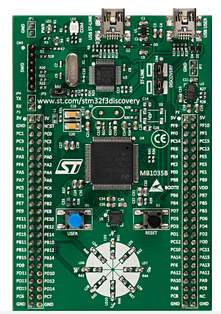
Integrating high-end sensors into evaluation boards accelerates the design cycle dramatically. Eventually, we could see an evaluation board that adds GPS or infrared sensing for prototyping autonomous robots. For example, the DIYdrones community is pushing the forefront of autonomous robot boards with their ArduPlane and ArduCopter designs.
Digging deeper into the specifications of the board, the STM32F3DISCOVERY is an evaluation board for the STM32 F3 Cortex-M4 microcontroller (STM32F303VCT6) Evaluation Board. The chip has 256KB of flash, 48KB Ram in a LQFP100 package and prices for less than $5 in 1000 quantity according to the STM32 datasheet. In terms of sensors, the board features a 3-axis gyroscope (L3GD20) and geomagnetic e-compass with accelerometer (LSM303DLHC). The standard features of the evaluation board include a USB port, LEDs and pushbuttons.
For those writing code, this chip is a standard ARM Cortex-M4 architecture which is the latest update to the Cortex-M Instruction set. Cortex-M3 code transfers easily to Cortex-M4 processors. Cortex M4 advanced beyond the popular M3 by featuring DSP extensions and optional floating point instructions. IAR and Keil are popular commercial platforms that support programming over ST-LINK/V2 interface. Open source solutions such as CooCox CoIDE and Yagarto with GNU-ARM support are also available.